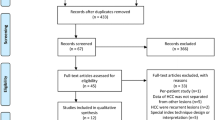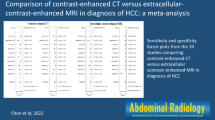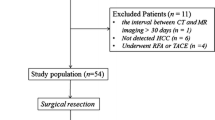Abstract
Aim
The purpose of this study was to determine the relative diagnostic benefit of gadolinium-ethoxybenzyl-diethylenetriamine pentaacetic acid (Gd-EOB-DTPA)–enhanced magnetic resonance imaging (MRI) over contrast-enhanced multi-detector computed tomography (CEMDCT) for the detection of hepatocellular carcinoma (HCC).
Methods
Two investigators searched multiple databases from inception to January 8, 2019, for studies comparing Gd-EOB-DTPA-enhanced MRI with CEMDCT in adults suspected of HCC. Two reviewers independently selected studies and extracted data.
Results
Eight studies were included enrolling 498 patients. MRI showed significantly higher sensitivity than CT (0.85 vs. 0.68). There was no significant difference in the specificity of MRI and CT (0.94 vs. 0.93). The negative likelihood ratio and positive likelihood ratio of MRI and CT were not significantly different (0.16 vs. 0.15 and 14.7 vs. 11.2, respectively). The summary receiver operating characteristics (SROC) of MRI was higher than that of CT at 0.96 vs. 0.91. In the subgroup analysis with a lesion diameter below 2 cm, the sensitivity of MRI was significantly higher than that of CT (0.79 vs. 0.46).
Conclusion
Gd-EOB-DTPA-enhanced MRI showed higher sensitivity and overall diagnostic accuracy than CEMDCT especially for hepatocellular carcinoma lesions smaller than 2 cm.
Key Points
• Gd-EOB-DTPA-enhanced MRI can detect small lesions of hepatocellular carcinoma.
• Gd-EOB-DTPA-enhanced MRI showed higher sensitivity and overall diagnostic accuracy than CEMDCT in patients with hepatocellular carcinoma.
• Eight prospective studies showed that Gd-EOB-DTPA-enhanced MRI provides greater diagnostic confidence.




Similar content being viewed by others
Abbreviations
- CEMDCT:
-
Contrast-enhanced multi-detector computed tomography
- DCE:
-
Dynamic contrast enhanced
- FN:
-
False negative
- FP:
-
False positive
- Gd-EOB-DTPA:
-
Gadolinium-ethoxybenzyl-diethylenetriamine pentaacetic acid
- HCC:
-
Hepatocellular carcinoma
- MRI:
-
Magnetic resonance imaging
- TN:
-
True negative
- TP:
-
True positive
References
Manini MA, Sangiovanni A, Fornari F et al (2014) Clinical and economical impact of 2010 AASLD guidelines for the diagnosis of hepatocellular carcinoma. J Hepatol 60(5):995–1001
Kim HD, Lim YS, Han S et al (2015) Evaluation of early-stage hepatocellular carcinoma by magnetic resonance imaging with gadoxetic acid detects additional lesions and increases overall survival. Gastroenterology. 148(7):1371–1382
Pascolo L, Cupelli F, Anelli PL et al (1999) Molecular mechanisms for the hepatic uptake of magnetic resonance imaging contrast agents. Biochem Biophys Res Commun 257(3):746–752
Yoo SH, Choi JY, Jang JW et al (2013) Gd-EOB-DTPA-enhanced MRI is better than MDCT in decision making of curative treatment for hepatocellular carcinoma. Ann Surg Oncol 20(9):2893–2900
Granito A, Galassi M, Piscaglia F et al (2013) Impact of gadoxetic acid (Gd-EOB-DTPA)-enhanced magnetic resonance on the non-invasive diagnosis of small hepatocellular carcinoma: a prospective study. Aliment Pharmacol Ther 37(3):355–363
Yoon JH, Lee JM, Lee YJ, Lee KB, Han JK (2019) Added value of sequentially performed gadoxetic acid-enhanced liver MRI for the diagnosis of small (10-19 mm) or atypical hepatic observations at contrast-enhanced CT: a prospective comparison. J Magn Reson Imaging 49(2):574–587
Di Martino M, Marin D, Guerrisi A et al (2010) Intraindividual comparison of gadoxetate disodium-enhanced MR imaging and 64-section multidetector CT in the detection of hepatocellular carcinoma in patients with cirrhosis. Radiology. 256(3):806–816
Li J, Li X, Weng J et al (2018) Gd-EOB-DTPA dynamic contrast-enhanced magnetic resonance imaging is more effective than enhanced 64-slice CT for the detection of small lesions in patients with hepatocellular carcinoma. Medicine (Baltimore) 97(52):e13964
Liu X, Jiang H, Chen J, Zhou Y, Huang Z, Song B (2017) Gadoxetic acid disodium-enhanced magnetic resonance imaging outperformed multidetector computed tomography in diagnosing small hepatocellular carcinoma: a meta-analysis. Liver Transpl 23(12):1505–1518
Kim BR, Lee JM, Lee DH et al (2017) Diagnostic performance of gadoxetic acid-enhanced liver MR imaging versus multidetector CT in the detection of dysplastic nodules and early hepatocellular carcinoma. Radiology. 285(1):134–146
Joo I, Lee JM, Lee DH, Ahn SJ, Lee ES, Han JK (2017) Liver imaging reporting and data system v2014 categorization of hepatocellular carcinoma on gadoxetic acid-enhanced MRI: comparison with multiphasic multidetector computed tomography. J Magn Reson Imaging 45(3):731–740
Inoue T, Kudo M, Komuta M et al (2012) Assessment of Gd-EOB-DTPA-enhanced MRI for HCC and dysplastic nodules and comparison of detection sensitivity versus MDCT. J Gastroenterol 47(9):1036–1047
Chen L, Zhang L, Bao J et al (2013) Comparison of MRI with liverspecific contrast agents and multidetector row CT for the detection of hepatocellular carcinoma: a meta-analysis of 15 direct comparative studies. Gut. 62(10):1520–1521
Hanna RF, Miloushev VZ, Tang A et al (2016) Comparative 13-year meta-analysis of the sensitivity and positive predictive value of ultrasound, CT, and MRI for detecting hepatocellular carcinoma. Abdom Radiol (NY) 41(1):71–90
Duncan JK, Ma N, Vreugdenburg TD, Cameron AL, Maddern G (2017) Gadoxetic acid-enhanced MRI for the characterization of hepatocellular carcinoma: a systematic review and meta-analysis. J Magn Reson Imaging 45(1):281–290
Lee YJ, Lee JM, Lee JS et al (2015) Hepatocellular carcinoma: diagnostic performance of multidetector CT and MR imaging-a systematic review and meta-analysis. Radiology. 275(1):97–109
Ye F, Liu J, Ouyang H (2015) Gadolinium ethoxybenzyl diethylenetriamine pentaacetic acid (Gd-EOB-DTPA)-enhanced magnetic resonance imaging and multidetector-row computed tomography for the diagnosis of hepatocellular carcinoma: a systematic review and meta-analysis. Medicine (Baltimore) 94(32):e1157
Guo J, Seo Y, Ren S et al (2016) Diagnostic performance of contrast-enhanced multidetector computed tomography and gadoxetic acid disodium-enhanced magnetic resonance imaging in detecting hepatocellular carcinoma: direct comparison and a meta-analysis. Abdom Radiol (NY) 41(10):1960–1972
Roberts LR, Sirlin CB, Zaiem F et al (2018) Imaging for the diagnosis of hepatocellular carcinoma: a systematic review and meta-analysis. Hepatology. 67(1):401–421
Whiting PF, Rutjes AW, Westwood ME et al (2011) QUADAS-2: a revised tool for the quality assessment of diagnostic accuracy studies. Ann Intern Med 155(8):529–536
Kim SH, Lee J, Kim MJ et al (2009) Gadoxetic acid-enhanced MRI versus triple-phase MDCT for the preoperative detection of hepatocellular carcinoma. AJR Am J Roentgenol 192(6):1675–1681
Akai H, Kiryu S, Matsuda I et al (2011) Detection of hepatocellular carcinoma by Gd-EOB-DTPA-enhanced liver MRI: comparison with triple phase 64 detector row helical CT. Eur J Radiol 80(2):310–315
Maiwald B, Lobsien D, Kahn T, Stumpp P (2014) Is 3-Tesla Gd-EOB-DTPA-enhanced MRI with diffusion-weighted imaging superior to 64-slice contrast-enhanced CT for the diagnosis of hepatocellular carcinoma? PLoS One 9(11):e111935
Tsurusaki M, Sofue K, Isoda H, Okada M, Kitajima K, Murakami T (2016) Comparison of gadoxetic acid-enhanced magnetic resonance imaging and contrast-enhanced computed tomography with histopathological examinations for the identification of hepatocellular carcinoma: a multicenter phase III study. J Gastroenterol 51(1):71–79
Imai Y, Katayama K, Hori M et al (2017) Prospective comparison of Gd-EOB-DTPA-enhanced MRI with dynamic CT for detecting recurrence of HCC after radiofrequency ablation. Liver Cancer 6(4):349–359
Ahn SS, Kim MJ, Lim JS, Hong HS, Chung YE, Choi JY (2010) Added value of gadoxetic acid-enhanced hepatobiliary phase MR imaging in the diagnosis of hepatocellular carcinoma. Radiology. 255(2):459–466
Huppertz A, Balzer T, Blakeborough A et al (2004) Improved detection of focal liver lesions at MR imaging: multicenter comparison of gadoxetic acid-enhanced MR images with intraoperative findings. Radiology. 230(1):266–275
Imbriaco M, De Luca S, Coppola M et al (2017) Diagnostic accuracy of Gd-EOB-DTPA for detection hepatocellular carcinoma (HCC): a comparative study with dynamic contrast enhanced magnetic resonance imaging (MRI) and dynamic contrast enhanced computed tomography (CT). Pol J Radiol 82:50–57
Hwang J, Kim SH, Lee MW, Lee JY (2012) Small (</= 2 cm) hepatocellular carcinoma in patients with chronic liver disease: comparison of gadoxetic acid-enhanced 3.0 T MRI and multiphasic 64-multirow detector CT. Br J Radiol 85(1015):e314–e322
Nishie A, Goshima S, Haradome H et al (2017) Cost-effectiveness of EOB-MRI for hepatocellular carcinoma in Japan. Clin Ther 39(4):738–750 e734
He X, Wu J, Holtorf AP et al (2018) Health economic assessment of Gd-EOB-DTPA MRI versus ECCM-MRI and multi-detector CT for diagnosis of hepatocellular carcinoma in China. PLoS One 13(1):e0191095
Funding
This study has received funding by the State Key Program of National Natural Science Foundation of China (No. 81430014); the National Natural Science Foundation of China (No. 81660103, No. 81771674); 111 Project (D17011); the National Institutes of Health (R01DK102912); Guangxi BaGui Scholars, Project of Guangxi Health and Family Planning Commission (No. S201602); the Project of Guangxi University Collaborative Innovation Center; the project to improve middle-aged and young teachers’ basic ability in universities of Guangxi (KY2016YB326); and Guangxi Key Laboratory of Molecular Medicine in Liver Injury and Repair(No. 16-140-46-04).
Author information
Authors and Affiliations
Corresponding author
Ethics declarations
Guarantor
The scientific guarantor of this publication is Songqing He.
Conflict of interest
The authors of this manuscript declare no relationships with any companies, whose products or services may be related to the subject matter of the article.
Statistics and biometry
One of the authors has significant statistical expertise.
Informed consent
Written informed consent was not required for this study because it is a meta-analysis.
Ethical approval
Institutional Review Board approval was not required because it is a meta-analysis.
Methodology
• prospective
• multicenter study
Additional information
Publisher’s note
Springer Nature remains neutral with regard to jurisdictional claims in published maps and institutional affiliations.
Rights and permissions
About this article
Cite this article
Li, J., Wang, J., Lei, L. et al. The diagnostic performance of gadoxetic acid disodium-enhanced magnetic resonance imaging and contrast-enhanced multi-detector computed tomography in detecting hepatocellular carcinoma: a meta-analysis of eight prospective studies. Eur Radiol 29, 6519–6528 (2019). https://doi.org/10.1007/s00330-019-06294-6
Received:
Revised:
Accepted:
Published:
Issue Date:
DOI: https://doi.org/10.1007/s00330-019-06294-6




